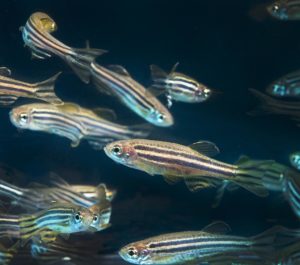
Several weeks ago saw the celebration of Diwali, the festival of lights. This festival represents the victory of light over darkness and of good over evil. The association of light with “good”, which can be seen in many human cultures, is reflected by the ability of light to positively influence mood. Prolonged lack of light during the day, as occurs in winter, can cause depression, while a burst of sunshine lifts the mood.
In addition to its ability to influence emotion, light can reset the circadian clock and change locomotor behavior. These effects are most strongly elicited by blue light, which is detected by melanopsin-expressing retinal ganglion cells found in the eye. One does not have to be able to see objects to be influenced by blue light. It is only the intensity that matters.
How does blue light have so many effects on animals? Neural tracing has shown that melanopsin-expressing ganglion cells project to many targets outside visual centers. While the function of some of these nuclei are clear, how they contribute to other aspects of non-visual responses are less well understood.
Shining a (blue) light on zebrafish behaviour

We have explored non-visual responses in zebrafish, which also have melanopsin-expressing cells in the retina. Larval fish generally move up in a water column during the day, and downwards at night. This behavior is controlled by the circadian clock, but can be overridden by blue light. By imaging the brain, we found that a nucleus in the anterior thalamus responds strongly to blue light. As demonstrated in the paper, this nucleus projects to the habenula, a brain structure present in all vertebrates that is a regulator of broadly acting neuromodulators, such as dopamine and serotonin, which have effects on movement and mood.
To manipulate the thalamic nucleus, we tested the ability of light-gated chloride pumps recently isolated from the microbe from Guillarda theta (GtACR1 and GtACR2) to inhibit activity in zebrafish neurons in vivo. As described in the paper, these pumps are highly sensitive. They provided us with the ideal tool: at light intensities that would normally trigger upward movement and depolarization of thalamic neurons, expression of these channels instead prevented neural activity. Fish that expressed these channels in the anterior thalamic nucleus failed to move upward in the presence of light, consistent with a role for this nucleus in the control of movement by light.
An interesting property of the anion channelrhodopsins is that the loss of actuating light causes a transient depolarization. In fish expressing the pumps in the anterior thalamus, offset of light caused a sudden upward movement, exactly as would be expected if depolarization caused climbing behavior. Thus, the ability of the ACRs to both inhibit and trigger activity can be beneficial in probing the function of a given neuronal population.
In an independent study, Zhang et al showed that a circuit involving melanopsin-expressing ganglion cells, anterior thalamus and habenula, mediates the preference of larval zebrafish for light over darkness. This suggests that reward could involve stimulation of the anterior thalamic nucleus.
An important question is whether the anterior thalamic nucleus found in zebrafish has homologs in other vertebrates. The answer is a tentative yes, as melanopsin-expressing retinal ganglion cells to have a termination in the anterior thalamus of mammals. The nucleus is relatively obscure, with some papers referring to it as the parahabenula region. Whether there is a link to the habenula in mammals remains to be demonstrated. If there is, this could be one way in which light affects emotions in humans.
- How does blue light affect animals? - 3rd November 2017
Comments